As of January 2021, 321,000 full-time-equivalent (FTE) jobs are supported by the legal cannabis industry. That is approximately a 15% year-over-year increase. While the acceptance of cannabis is highly contested, the industry gained new legitimacy within the United States with the onset of the coronavirus lock downs.
In March of 2020, most legal states deemed cannabis “essential business”, meaning dispensaries could stay open and keep serving their communities, and brands could keep supplying retailers with their products. Given the federal status of cannabis, this new designation was a pivotal moment for the industry.
From medical dispensaries to recreational retailers and everything in between, the cannabis business is showing no signs of slowing down.

The question remains: What makes these businesses so successful? More importantly, how can a new cannabis business take advantage of this time in history and explore marketing strategies to ensure their success?
This e-book will break down the six key areas of cannabis marketing: branding, website design and development, search engine marketing, email and text marketing, and social media.

INTRODUCTION TO CANNABIS MARKETING
Although the legal status of cannabis is increasingly changing in a number of states, the plant remains federally illegal. In fact, according to a Pew Research survey, 67% of Americans believe the use of marijuana should be legalized. The result is a regulatory environment that does not align with cannabis entrepreneurs and their prospective customers.
From a marketing perspective, this often requires education for cannabis business owners and their customers. At Cannabis Creative, we find that many of our clients need a crash course in marketing regulations because it can be hard to understand what you can and cannot say and what channels these rules apply to.
For instance, it is important to keep Google and Facebook happy by successfully navigating within these restrictions. This means being hyper-aware of wording and content published to your website, landing pages, and social media to be sure that you can stay up and running online.
Moreover, a lot of cannabis businesses have limited funding and are looking for very specific goals to achieve with their marketing efforts. Non-cannabis businesses tend to have a stable enough revenue stream to fund marketing activities that allow them to invest in longer-term campaigns, such as social media.
Therefore, cannabis businesses look for more targeted marketing activities to achieve their goals and pay closer attention to key performance indicators (KPIs) for cannabis marketing accordingly.
KPIs for Cannabis Marketing
| Goal | Marketing Activities | KPIs |
|---|---|---|
| ATTRACT: Build Brand Awareness / Authority This is meant to target cold leads. |
|
Impressions, followers, email list subscribers, etc. |
| CAPTURE: Create Customer Loyalty This is meant to target warm leads. |
|
Comments, open rates, repeat purchases, etc. |
| CONVERT: Increase Revenue This is meant to target hot leads. |
|
Conversion rates, sales, revenue, etc. |
As with all industries, marketing is informed first and foremost by the target audience. In the case of cannabis, there is a big difference between consumer-facing cannabis businesses (dispensaries, cannabis consumer products, etc.) and business-to-business (B2B) cannabis businesses (cannabis drying, growing services, etc.). The methods of engagement and follow-through, as well as the challenges, vary for each business type respectively.
With B2B cannabis businesses, it is difficult to engage other businesses enough to generate significant leads and follow through with purchases or partnerships. On the other hand, with customer-facing businesses, such as dispensaries, there is a struggle with brand awareness and building a loyal community.
Cannabis Creative has extensive experience working with both types of businesses and our teams are well-equipped to navigate the challenges of each respective landscape. This e-book will pull examples from primarily customer-facing businesses, but the accompanying insights and marketing tips are applicable to anyone operating in this ever-growing industry.
Marketing Challenges Vary for Cannabis
By nature of legislation and local progress, marketing challenges also vary by location. For instance, the Massachusetts cannabis industry is far behind those of California and Colorado, but ahead of others. Engaging customer bases can be difficult in newer states where cannabis may still have some stigma associated. However, since states like California and Colorado are more established, brands in those states are often less inclined to implement more innovative marketing strategies.
As we explore the areas of branding, web design and development, search engine marketing, email marketing, and social media, it is important to keep these marketing challenges in mind. From advertising restrictions and audience preference to business limitations, the landscape of the cannabis industry greatly informs the marketing practices available to building successful cannabis businesses.
YOUR CANNABIS BRAND
Take a look around you. Chances are, you are surrounded by brands. From the device you are reading this e-book on, to the clothes you are wearing, our world is filled with businesses who successfully build their brands and attract their ideal customers, like you.
A brand is a multifaceted expression of your business. It is the way a company, organization, or individual is perceived by those who experience it. In other words, more than the visual identity or even name, it is the recognizable feeling a product or business evokes.
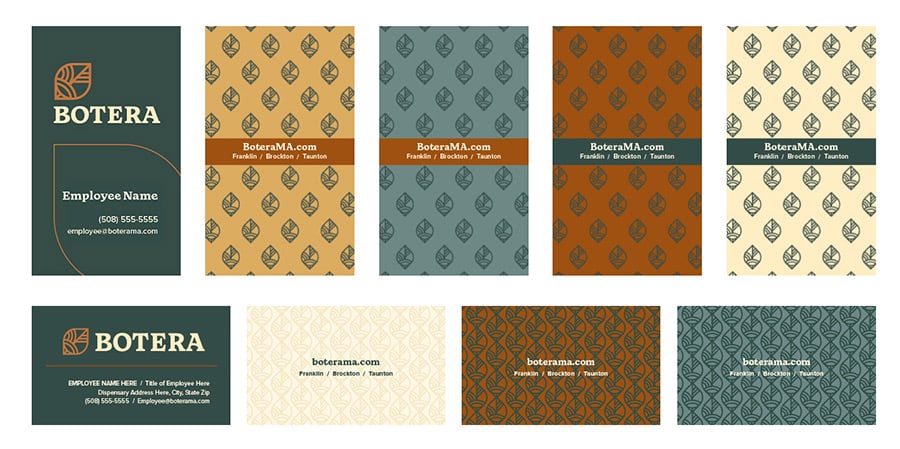
Simply put, brands are perceptions.
What does this mean for you as a cannabis business? It means that everything from your in-store dispensary environment to your social media photos and videos to your website copy should fully display your brand vision. Logos, color palettes, typography, style elements: these are all important parts of a consumer’s interaction. They have to be developed thoroughly and accurately for your ideal consumer to find you and resonate with you.
Brand Identity
Your brand identity defines who you are. It is the personality and values your business brings to the table, and often a key element in the reason you got into the industry in the first place.
If you were to imagine your business as a person, you should be able to answer questions about its personality. For instance, is your business fun and relatable? Knowledgeable and informative? These characteristics help inform a number of decisions about your business. To fully and effectively implement a brand strategy, your brand identity should be strong and consistent, from your brand voice which you implement in all your content and copy to your visual identity, which is expressed across channels – both digital and otherwise.
When it comes to the cannabis industry, it is important to take these elements a step further. For instance, it is crucial to be aware of regulations when designing a logo. Several states prohibit logos and signage that include references to cannabis or cannabis-related products, such as imagery of a cannabis leaf, smoke, or other forms of cannabis like joints, bongs, and so on.
Although it is a challenge to design a logo that clearly communicates what type of business you operate without actually alluding to cannabis, the industry is full of professionals that can easily achieve this goal while working with you to craft something that represents your brand.
In-Store Environment
If you are a dispensary, the in-store experience is a major touch point of your brand for customers. This is where they can explore your offerings and really revel in the ambiance you create. Those feelings and emotions that are associated with their experience, from customer service to the indoor aesthetic, are a large part of your brand as a cannabis business.
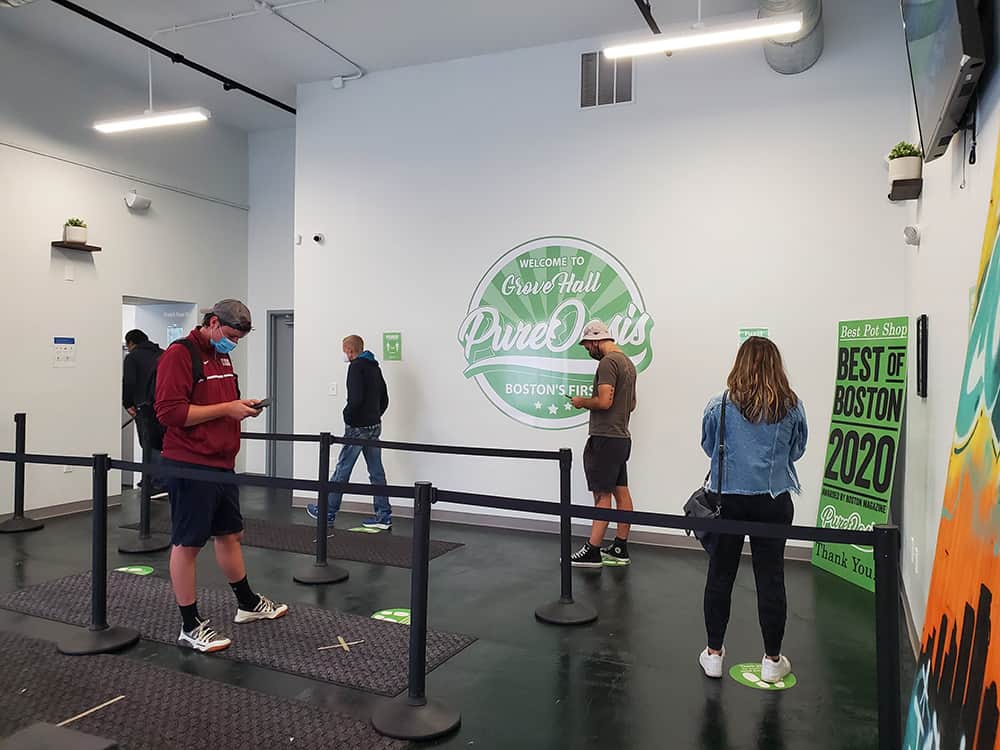
This can be further refined based on what type of dispensary you operate: medical or recreational. For instance, medical dispensary customers want to feel safe and comfortable ordering their medicinal cannabis. They often want savings and easier access to products since they are using it for their health and wellness. Medical dispensaries, therefore, should aim to focus on creating an experience of comfort.
Recreational users, on the other hand, are a bit more experimental. They are open to trying different strains, different types of products, etc. There isn’t necessarily a sense of loyalty to a particular dispensary, so it is harder to have “fans” of a recreational dispensary the same way as restaurants or other retail brands.
The bottom line is that as more states legalize cannabis and the industry expands at a rapid pace, businesses need to develop a competitive edge through distinct branding practices. For dispensaries, this can be done through thoughtful interior design, physical space, store playlists, and even menus.
Another thing to keep in mind is that there is no industry untouched by the coronavirus. When our current reality passes and consumers feel comfortable going into stores again, it is likely that they will feel differently about small or crowded spaces. Retailers should re-imagine their store layouts to increase space between customers or consider offering order-ahead buying models with in-store up-sell opportunities.
Overall, a strong brand identity establishes trust and can separate your business from the rest by connecting with customers that share your values.
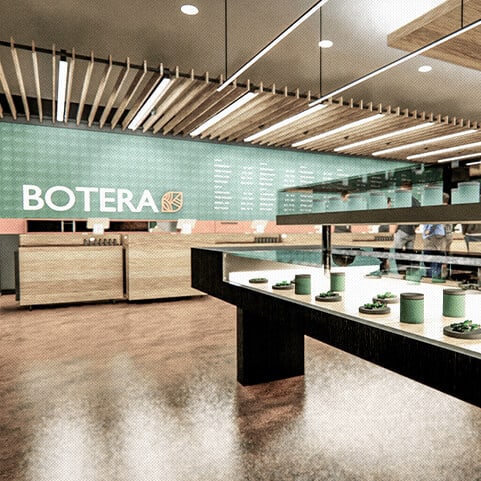
BEHIND THE SCENES: BOTERA
Botera came to us with no name, no brand standards. We worked with them on what general brand vision they had in mind and from there, the design team at CCG built out their customer experience. In their case, the brand vision focused on the physical in-store experience: ambiance, physical space, playlist, etc.
“Botera is all about giving each individual customer their own, individual cannabis experience. They help customers find their cannabis, their way. Some people know exactly what they want so they order ahead and pick up. Others want to learn the ins and outs of each product with a dedicated budtender. We worked hard to make sure the in-store experience felt great for both with a warm, welcoming, natural, and modern aesthetic that can be as comfortable or as quick as you’d like. You can find your plant, your way. Again and again.
“The customer’s in-store experience is critical for a dispensary’s long-term success. More and more dispensaries are popping up, selling many of the same exact products for relatively the same price, so one of the real differentiators for a customer choosing one over another will be that in-store experience. How well it works and how it makes them feel is immensely important. That’s what will create a real connection with them and bring them back again and again.”
Chris Milne, Creative Director at Joe the Architect
Photography & Video
Menu engineer Greg Rapp’s research shows that one photograph per page on a restaurant menu can increase sales for that menu item by up to 30%. Similarly, fast food and quick-serve restaurant customers are typically drawn to screens with product images and menu listings when deciding what to order.
Ultimately, this research speaks to consumer behavior and the preference in evaluating products through images. For cannabis businesses with a brick and mortar location, in-store screen marketing can encourage customers to purchase products with associated images.
Cannabis Creative partners with businesses like GreenScreens, who work with the biggest names in the cannabis industry, to help our clients enhance customer experience and ultimately increase profitability.
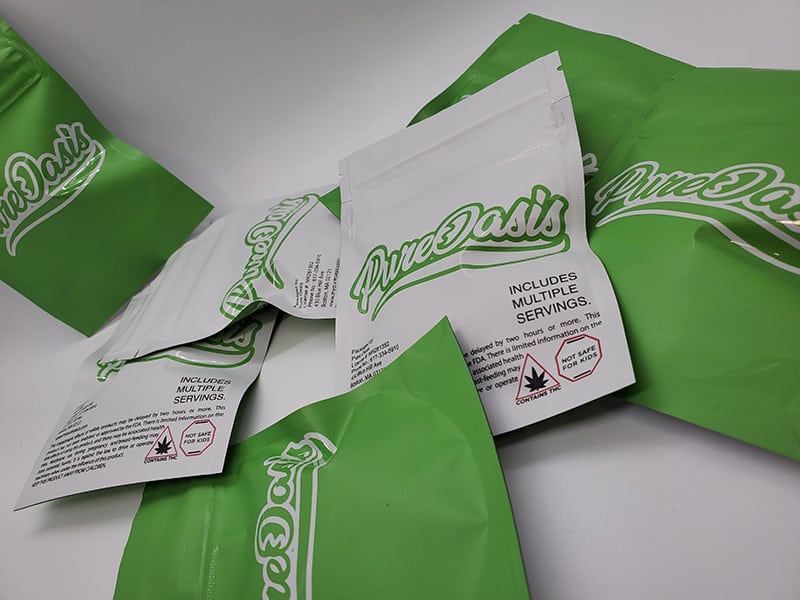
GreenScreens is a leading in-store digital cannabis advertising network at the point of sale. They provide a platform that helps dispensaries inform customers, allows brands to advertise, and collects consumer data within the cannabis industry. Their digital screens are programmed to show product menus, announcement boards, social media, advertisements and much more.
By providing intelligent, responsive experiences to your customers through in-store screens, your brand can digitally engage and interact with customers, measure and adapt to their behavior, and even support your store associates.
Utilizing high-quality photography and video assets goes beyond the in-store experience as well. Video, in particular, can be incredibly useful for e-commerce businesses.
Your video can be shared on YouTube as well as other manufacturers’ sites. A video explaining the product, showing users using the product (30-60 seconds), and having reviews from real people can really encourage customers on the fence to purchase a product.
According to the annual 2020 Wyzowl Video Marketing Report, the pandemic has overwhelmingly increased the amount of online video people watch. With the rise of platforms and features like TikTok, Instagram Reels, and more, video is becoming a larger part of the marketing mix than ever before. Of the people who reported that their business does not currently use video, 69% said they expect to start in 2021, a 10% increase from 2020’s figure of 59%.
The truth of the matter is that video marketing is bigger than ever and brands must take advantage of this trend to keep up with their customers.

CANNABIS WEB DEVELOPMENT & DESIGN
Your website is the first handshake you have with a potential customer. It is critical to have a fully functional, user-friendly, mobile-friendly, and visually appealing website that is designed with your marketing objectives in mind.
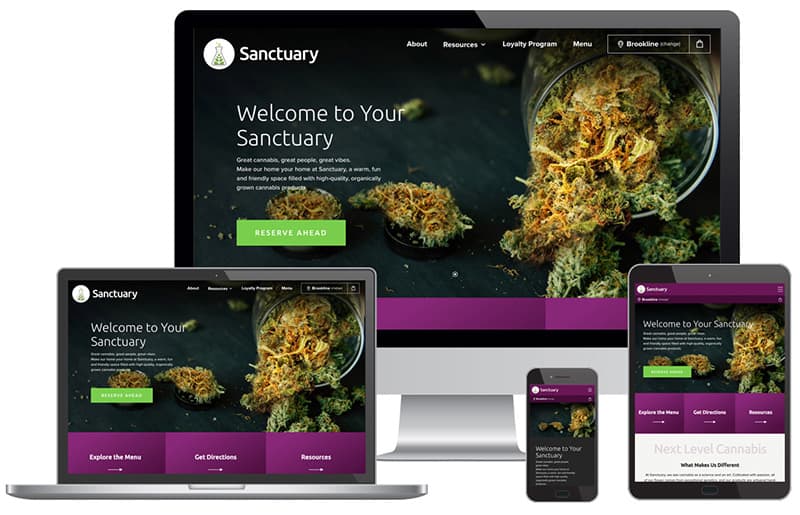
Due to the cannabis industry’s novelty, new brands and sites are popping up quickly. New business owners are often eager to get their product in front of people and outsource their website to whoever they can get in touch with. The problem here is that designing your cannabis website intentionally and correctly from the beginning is the make-it-or-break-it factor that will have you standing out from the crowd.
The key to differentiating yourself from the competition is to have a visually appealing and effective website.
Understanding Your Why
When we work with our clients on website design and development projects, we always start with one question: Why?
Why do you want to build your business website? What is the primary goal of your website? What do you want to happen? Are you looking to increase in-store foot traffic or generate online purchases?
Brands need to have a clear goal on what they are marketing and what results they are trying to achieve with the design of the website. In this sense, a good website should have clear and simple navigation: fewer choices, simple pages.
The Nielsen Norman Group found that in order to capture a site visitor’s attention, you must clearly communicate your value proposition within 10 seconds. However, user experience (UX) experts have found that “When we give users more than 5 seconds to study the page, we’ve found they start looking at the page more like a designer, noticing details they would normally miss or misinterpret”.
In other words, your website’s why should be clearly identifiable within the first five seconds of being on the site to capture visitors.
For cannabis or CBD product brands like our clients, Red Zen or Wisdom Essentials, this might mean building a community around the brand. To do so, the primary goal of the website could be to capture readers and turn them into email subscribers or Facebook Group members. For dispensaries, it could be encouraging purchases. For B2B cannabis businesses, it could be getting site visitors to trial your service or book a call.
No matter what the goal is, your customers should not have to jump through hoops to get to the page that has the action item you want to lead them to. In marketing terms, this means you need to optimize your buyer’s path or journey.

A good website should be easy to navigate. Your visitors should be able to find important information right away: hours, location, contact forms, email signups, etc. There are different goals behind each feature. For instance, a medical cannabis page might have more concrete steps to book an appointment or get a card, while enticing adult-use shoppers involves being more creative and roundabout.
Another example is that dispensary websites should have a clear button to get to their menu immediately. It is likely what consumers are there for in the first place; they should have easy access to that content. Similarly, B2B business websites should be transparent about specifications (size, output, etc.) and have a frequently asked questions section. This avoids confusion for site visitors and filters out any need for communication about product/service questions from real leads.
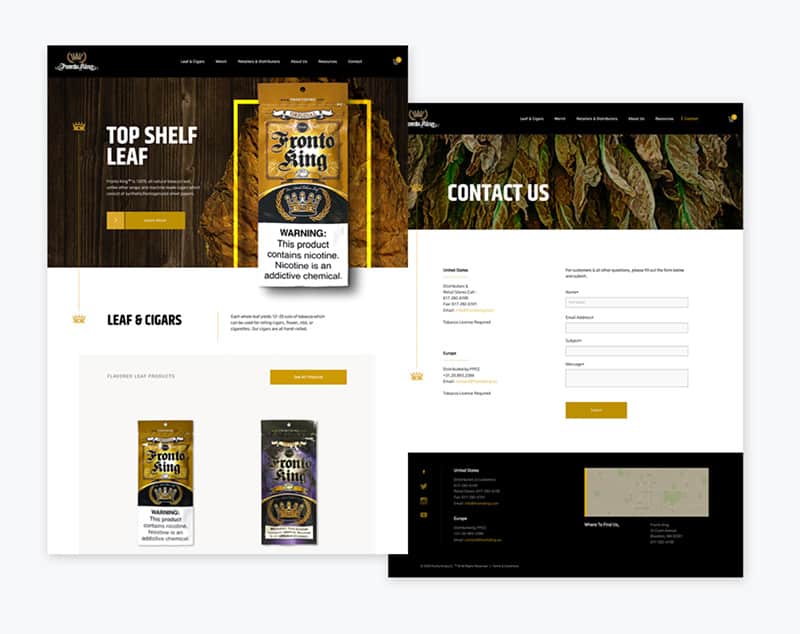
“What if I have more than one why?”
While there may be multiple goals for each section of the website, one page should not be overwhelmed with multiple goals. For example, when we designed our client BFF Hemp’s homepage, the goal was to increase sales of their CBD product. Therefore, when you visit the website, you can really only do two things: shop or learn more about the company. Because their site’s purpose is to sell CBD, everything leads a visitor to the shop products page.
Some cannabis businesses, such as dispensaries, may have a retail store and online shopping platform. In these situations, you have to make a decision and clearly guide a site visitor based on your goal.
Factors to consider in making that decision might include your biggest return on investment (ROI). Are you making more online or in-person? Which experience builds more customer loyalty?
The primary focus of website design and development will always be to inform the buyer’s journey. There should be an informed reason for each feature and element on your site, instead of just liking the way it looks.
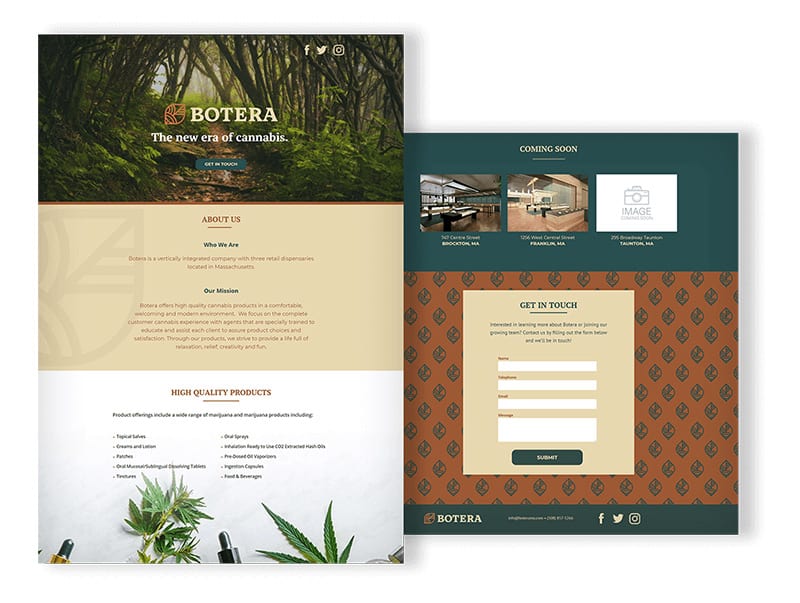
E-Commerce Features
There are a set of standard practices for a good buyer journey and these are typically the features that you would expect to see on any e-commerce website or platform. From a good layout and high-quality product images to intuitive categorization of products and useful product filters, your product shopping page needs to be functional and detailed.
This page should have all the needed tools to sort through a product by features, such as color, price, rating, etc. When a user clicks into each product, they should be able to see high-quality images, good descriptions, testimonials/reviews, and other information that your customer would need to know before making the decision to purchase.
Users who purchase online are likely to turn to different factors when evaluating whether or not the product is right for them. One of these deciding factors is the product image. Customers want to see the product they are getting and it can deter them if there is no image. Although it takes an additional investment to get professional product photography done, it is so important to have on the site.
Ultimately, as the site visitor follows the buyer’s journey along different pages of your website, you want to convince them that your product and your brand is worth purchasing from.
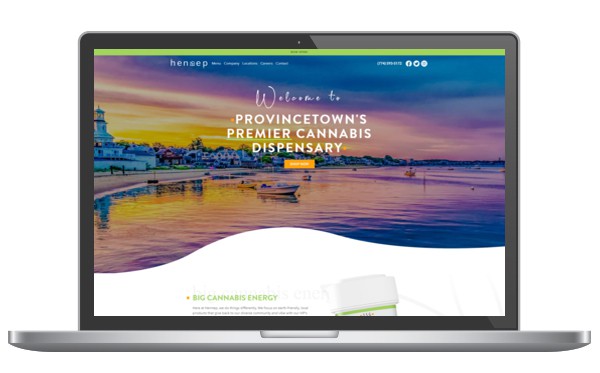
You can even enhance this experience by including features such as a suggested products reel to cross-promote other products or an easy-to-use shopping cart and wishlist. To see if these features are actually working, you have to constantly tweak your website strategy.
In other words, once your site is up and running, it is not a done deal. For instance, you might play around with the layout of your product page to drive people to different products and then conduct A/B testing to see which layout works better. This is helpful because unlike the physical space of a restaurant or dispensary, websites allow you to see exactly where users found you and how they got to your site.
In this way, you can narrow down exactly how a user navigated through your website and track where they went before they converted. Then, you can keep using the same path to convert more and more people.
Inventory Management & Integration
A major pain point with cannabis businesses tends to be online ordering systems and inventory management. Payments can be tricky and sometimes that means you have to manually update your inventory, which makes it extremely difficult to give customers a seamless experience.
This is where inventory management partners such as Jane Technologies and dutchie come into the picture. These partners fully automate e-commerce platforms for cannabis retailers. Their menus allow your brand to be highlighted while their technology converts the highest possible percentage of browsers into buyers.

Overall, consumer expectations around purchasing have changed thanks to COVID-19, and will likely persist even after the crisis is over. The technologies that consumers expect from retailers in traditional industries, like online ordering and payments, delivery, and up-to-date digital menus, are now taking hold in cannabis. Dispensaries will need to figure out their e-commerce strategy, including which technology partners they can rely on, in order to keep up.
CANNABIS SEARCH ENGINE MARKETING (SEM)
Having a visually appealing, functional, and efficient website creates a great user experience, but its existence alone will do nothing for your business until you get traffic to it. SEM, or Search Engine Marketing, is that arm of marketing that can completely transform the online presence of your business. In fact, 93% of all online experiences start with a search engine.
There are three main types of SEM – all aimed at helping you earn greater visibility in search results: local SEO, organic SEO, and pay-per-click (PPC).
SEO is the process of improving both the quality and quantity of traffic to a website or a web page through unpaid, or organic, search engine results. Implementing the right campaign strategy with constant vigilance over time is what it takes to build traffic. Combined, organic and paid tactics, such as PPC, can grow your return on investment (ROI) and increase your website traffic and ultimately be a game changer for your business.

With time, these pillars of your SEM strategy can certainly be managed and fully understood by your brand on your own. However, a team of SEO professionals can get the best results and truly reap the benefits of an effective SEO strategy, particularly for a cannabis brand.
Overall, a comprehensive SEM strategy is one that takes organic and paid tactics into consideration, and incorporates local SEO to reach your target audience.
Content Is Key
Without quality content, search engine optimization efforts are simply boosting content that your audience is not interested in. Therefore, the first step to having a good search engine marketing strategy is to never underestimate the importance of high-value, engaging content. This is ultimately the key to what helps SEO tactics take off.
The key to keeping Google happy is to bring people to your website without promotions about cannabis. This means creating engaging content that is less sales-oriented and more fun and practical.
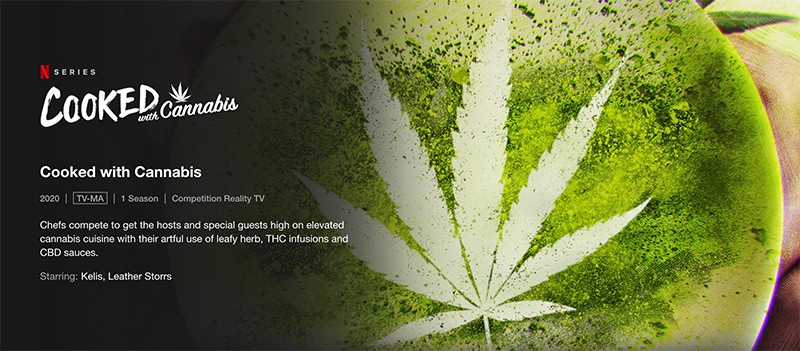
Blogs are a great resource to share with your audience to build and nurture a relationship with them. You can post about relevant information like current events in the area, new strains, recipes, behind the scenes, etc.
General education topics like the different strains available and their effects are good for consumers who know how to use cannabis in their own way but like to learn about more uses. Trending topics might be fun ways to integrate cannabis into cooking. There’s even a Netflix show on this!
Our client, Sanctuary, uses their blog really well. For instance, their team will write about exciting recipes, such as how to make cannabis butter, but they also sell the product too.
We then promote their blog content across channels – email, social media, SEO, etc. – therefore, driving traffic to this page. When people go to the blog to read the recipe, they might try to buy what is necessary to make cannabis butter themselves, but more likely, they will see that Sanctuary actually sells the product and go ahead and purchase the product now that they have some additional insight as to how it’s made.
In other words, a good piece of content can bring high-intent users to your site and encourage them to purchase, all without spending a dime.
Paid Search Tactics
Of course, sometimes you want to put a budget behind your content. The truth is that the most success e-commerce businesses see is typically from paid search campaigns.
For dispensaries and other brick and mortar stores, Google Ads and local search ads are an effective strategy for a number of reasons.
Most notably, paid search tactics are highly relevant and bring fast results. You can boost your website ranking within Google Search and get your dispensary or cannabis brand in front of high-intent, local users searching for your products or services. When done correctly, you can target users by location down to the zipcode and turn marketing dollars into meaningful foot traffic.

Additionally, unlike SEO, which is a long-term strategy that could take months or even years, search ads allow you to start ranking for your desired keywords immediately. This often means ranking higher than your competitors as well. Better yet, you get to be in full control of your budget. With Google, you can easily scale campaigns and avoid getting locked in to a minimum ad budget or bid strategy. Instead, you can start small and scale up as you see results.
While there are limitations in the cannabis space, such as with social media, paid search ads are still highly measurable for cannabis businesses. From tracking conversions back to specific keywords and ad copy to identifying successful design, you can easily justify your ROI and gain deeper insight into your production efforts.
These benefits make paid search ads a wildly successful tactic for cannabis businesses. However, due to its federal status, paid advertising of cannabis or CBD products is prohibited by digital platforms like Google Ads.
Working around this requires crafting unique, Google Ads-compliant landing pages and implementing ad strategies that target users searching for dispensaries within a given radius of their location.
Although cannabis businesses have a hard time advertising through Google, Cannabis Creative has found a significant way to work around restrictions and create landing pages by using keywords that we can safely target. These are creative advertising solutions that only working with cannabis marketing professionals will get you.
To effectively measure the results of a PPC campaign, you must continually test and optimize all areas of the campaign from ad copy, landing page copy, landing page design, offers, email drip campaigns, keyword targets, keyword bids, locations, budgets, etc. to generate the highest conversion rate.
Digital marketing agencies have teams of PPC professionals who have mastered the best practices in this area. For instance, Cannabis Creative’s expert PPC team has an entire toolkit of strategies to help cannabis businesses reach their advertising goals without being flagged by Google.
CANNABIS EMAIL MARKETING
Email marketing presents a significant opportunity at a time when many traditional and digital marketing tactics are highly restricted for cannabis and cannabis-related businesses, including direct mail, print advertising, Facebook advertising, Google AdWords, and social media marketing.
It is the most clear tool we have in the cannabis industry.
In fact, research by Campaign Monitor found that for every $1 spent on email marketing, businesses get $44 in return. Moreover, when it comes to social media followers, you do not actually have full access to your followers. In other words, if you wake up tomorrow and all your social media platforms are taken down, your following is also gone. Unlike social media, you own your email list subscribers.
Cannabis businesses achieve a better return by focusing their efforts on incentivizing email sign ups as a way to communicate and nurture audiences.
Cannabis Creative Insider Secret
Use automated email marketing workflows to schedule newsletters and campaigns to go out whenever triggered by a specific variable. This could be as simple as the date or as complex as a customer’s action.
These strategic workflows collect user information and provide positive reinforcement in customer’s inboxes at appropriate times. As a cannabis marketing agency, we have seen B2C marketers who leverage automation to result in conversion rates as high as 50%.
Automated emails are really helpful to get customers back on the site. This could include drip campaigns, abandoned cart emails, or nurture campaigns after a purchase or booking.
In other words, whenever you collect an email, there should always be an automatic follow up email. This allows you to build that relationship with your customers at every touch point in your business. From providing more information and leading them to your blog, to offering exclusive rewards and featuring your customers, you should aim to gently guide your community through their buyer’s journey.
Nurture Campaigns
A nurture campaign is a series of behavior-based emails. The goal is to deliver useful information to your subscribers while they engage with your brand. To do this, email marketers use data gathered from the user’s behavior to deliver timed and targeted messages.
An example of this is when a new lead enters their name and email address on your website to receive a lead magnet on your website, such as an e-book. A nurture campaign ensures that not only are they using their lead magnet, but returning to your website.
This may look like a series of follow-up emails asking how the user is liking the e-book, testimonials of other readers who have seen success because of the e-book, and perhaps finally, a call to action to set up a consultation to help implement the content in the e-book.
Ultimately, this type of sequence guides the prospect through your buying process and equips them with the information necessary to make a purchase decision.
Drip Campaigns
A drip campaign is a series of time-based emails that are meant to encourage a very specific action, such as purchasing a product, warming up a lead, registering for an event, and so on.
These emails are strategically thought out to push your audience towards the action you want them to take. Similar to a nurture campaign, each email stands alone but builds on the emails that came before it.

The benefit here is that you can consistently show up with your value proposition to educate your audience on your company’s portfolio and warm them up as they engage with you. However, it is important to build out drip campaigns with caution as they can seem excessively sales-y and turn people away from your business if your emails are not written carefully.
An example of a drip campaign is the sequence of emails you receive when a store releases a new product. This may include an announcement of the new arrival in-store, a promotional code to access the product before anyone else, a full line-up explaining the new product, and a last email that implements the product in a lifestyle setting (also known as the product’s use case) or shows what other customers are saying about it.
Text Messaging (SMS) Campaigns
A new trend emerging in the realm of cannabis marketing is text campaigns. These campaigns not only allow businesses to measure sales much easier, but are also highly effective:
- 90% of users who enroll in a text loyalty program feel they gained value from it.
- Text messages are usually read within 5 seconds of receipt.
- Text coupons are 10 times more likely to be redeemed than print or emailed coupons.
- 70% of people say they would actually prefer to receive offers on their mobile phones.
Text campaigns are one of the more innovative marketing strategies that have cropped up in recent years in the cannabis space. However, as mentioned before, it is important to keep an eye on such trends, particularly when they are working. This is why Cannabis Creative has partnered with Sprout to give our clients access to new ways of reaching their customers.
Sprout is a leading CRM & marketing software company in the cannabis industry. Their all-in-one CRM & marketing software helps automate marketing functions, build brand loyalty and engage consumers and patients.

CANNABIS SOCIAL MEDIA
It is no secret that the cannabis space struggles primarily with paid advertising – and it is no different when it comes to social media. From Instagram, Facebook, Twitter, LinkedIn, Pinterest, Snapchat, and even TikTok, marketing restrictions placed on the platforms make it that much harder for dispensaries and other cannabis brands to grow an audience.
These are major roadblocks because it also happens to be where the majority of a brand’s target customers are most present. According to eMarketer, the average U.S. adult spent 3 hours and 6 minutes a day on a mobile device in 2020. More specifically, social networking applications have gained the most extra minutes year-over-year: an additional 11 minutes per day for the average adult.
For marketers, this is a clear indication that in order to meet people where they are, social media marketing must be used, and it must be used wisely. This is particularly true when it comes to the cannabis industry since paid advertising is not allowed for these products.
Being Social on Social Media
The hardest part of social media for business owners to understand– even those outside the cannabis industry – is that it is a channel used to create brand awareness, not sales. Organic or original content on social media is meant to build a community around a brand and nurture an audience into becoming loyal fans.
The distinction between selling and socializing on social media is especially important for the cannabis industry to avoid getting blacklisted or banned from social media platforms.
We have often seen accounts getting shut down with thousands of followers and completely losing their account growth – a harsh reminder that while social media is important, it is not an owned channel.
Therefore, in order to build your brand without being flagged, you have to be well-acquainted with the way each social media platform reads its posts. For instance, with Instagram and Facebook, the algorithm understands flower images. In recent months, we have seen many dispensary accounts get shut down for posting mere images of cannabis. Our social media team carefully considers how these platforms have been behaving before creating content for our clients that best showcase a given cannabis business’s product or service offerings.
Another general rule to follow is to avoid listing a price or including any sort of selling language on your social media posts, whether that is in the post itself, the alt text, or the caption.
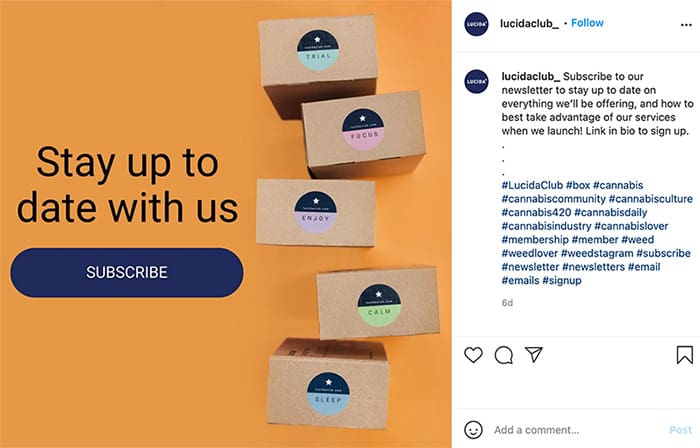
These and other factors play a large role in the type of organic content you can create for your business. However, customers always react positively to human-first content. This has been particularly true since the pandemic has shifted trends on social media. Platforms like Instagram are being used less frequently in favor of more authentic content platforms, such as TikTok or even Clubhouse.
In order to be successful on social media and really be social with your audience and community, it is important to prioritize engagement and quality organic content that truly reflects your brand so that you can show up in a meaningful way, and not just to maintain a presence.
Paid Social Advertising
The requirements and restrictions surrounding paid advertising on social media are hardly a secret. Cannabis businesses have to tread carefully to avoid getting shut down or banned from platforms, and even when a workaround has been implemented, it has to be consistently monitored.
Although this makes it really difficult for dispensaries and cannabis brands to drive traffic to their stores or sites, there are inventive ways of finding loopholes, much like with search engine marketing. However, these are typically better left to professional agencies, like Cannabis Creative, that are equipped with the teams necessary to implement larger-scale workarounds, like duplicate “safe” landing pages and accounts.
Another way to leverage the use of social media advertising without risking your account is to partner with influencers. An influencer is any person or platform that has influence over an audience. These influencers tend to be content creators in some way, and many become brand ambassadors.
In doing so, they are not directly working for or representing the brand or company, but instead acting as an individual recommending a product or brand. Influencer marketing lets cannabis brands promote their products without getting tangled up in the mess of marketing legalities.
SUMMARY
In spite of the challenges that come with marketing cannabis online, there are ways to sidestep regulations and leverage what is currently allowed to build your brand. Organic content and owned channels provide the perfect opportunity for cannabis businesses to educate their audience, build brand awareness, and cultivate a community without using the aggressive paid techniques that could get your account banned.
In the end, it is essential that cannabis businesses find ways around online advertising limitations and restrictions so they can promote their sites and products. Finding loopholes in ad policies, such as by dropping hints about the product instead of naming it, requires walking a fine line between adhering to and violating terms of use.
However, an investment in working with a cannabis marketing agency will be the difference between successfully utilizing a paid ad strategy and having your ads shut down or account suspended entirely, neither of which are worth the risk.
Cannabis Creative’s Boston-based team has decades of experience in web design & development, SEO, branding, email and social media marketing, and content strategy. We have boosted our clients’ exposure, both locally and nationally, and can help cannabis businesses of all kinds reach a broader market and succeed in this ever-expanding field.
